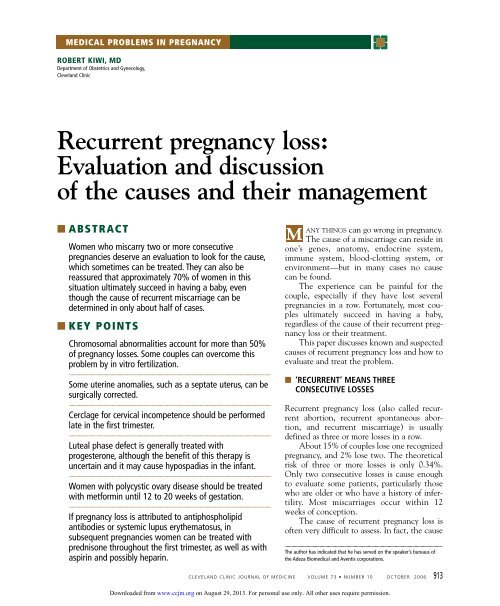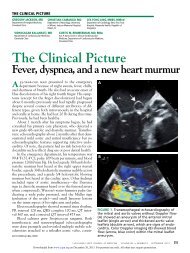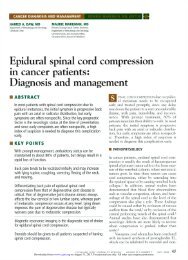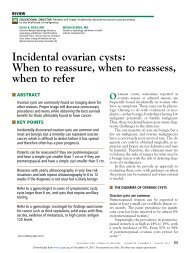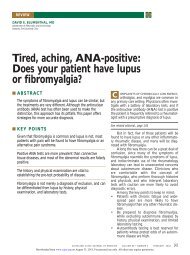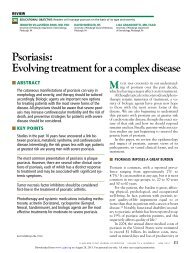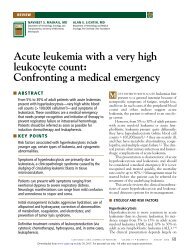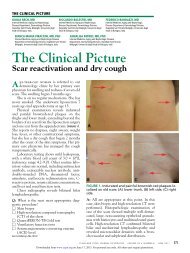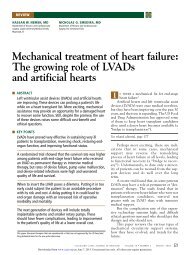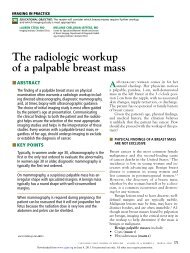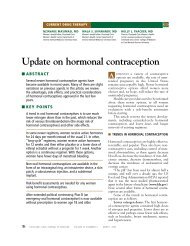Recurrent pregnancy loss: Evaluation and discussion of the causes ...
Recurrent pregnancy loss: Evaluation and discussion of the causes ...
Recurrent pregnancy loss: Evaluation and discussion of the causes ...
You also want an ePaper? Increase the reach of your titles
YUMPU automatically turns print PDFs into web optimized ePapers that Google loves.
MEDICAL PROBLEMS IN PREGNANCY<br />
ROBERT KIWI, MD<br />
Department <strong>of</strong> Obstetrics <strong>and</strong> Gynecology,<br />
Clevel<strong>and</strong> Clinic<br />
<strong>Recurrent</strong> <strong>pregnancy</strong> <strong>loss</strong>:<br />
<strong>Evaluation</strong> <strong>and</strong> <strong>discussion</strong><br />
<strong>of</strong> <strong>the</strong> <strong>causes</strong> <strong>and</strong> <strong>the</strong>ir management<br />
■ ABSTRACT<br />
Women who miscarry two or more consecutive<br />
pregnancies deserve an evaluation to look for <strong>the</strong> cause,<br />
which sometimes can be treated. They can also be<br />
reassured that approximately 70% <strong>of</strong> women in this<br />
situation ultimately succeed in having a baby, even<br />
though <strong>the</strong> cause <strong>of</strong> recurrent miscarriage can be<br />
determined in only about half <strong>of</strong> cases.<br />
■ KEY POINTS<br />
Chromosomal abnormalities account for more than 50%<br />
<strong>of</strong> <strong>pregnancy</strong> <strong>loss</strong>es. Some couples can overcome this<br />
problem by in vitro fertilization.<br />
Some uterine anomalies, such as a septate uterus, can be<br />
surgically corrected.<br />
Cerclage for cervical incompetence should be performed<br />
late in <strong>the</strong> first trimester.<br />
Luteal phase defect is generally treated with<br />
progesterone, although <strong>the</strong> benefit <strong>of</strong> this <strong>the</strong>rapy is<br />
uncertain <strong>and</strong> it may cause hypospadias in <strong>the</strong> infant.<br />
Women with polycystic ovary disease should be treated<br />
with metformin until 12 to 20 weeks <strong>of</strong> gestation.<br />
If <strong>pregnancy</strong> <strong>loss</strong> is attributed to antiphospholipid<br />
antibodies or systemic lupus ery<strong>the</strong>matosus, in<br />
subsequent pregnancies women can be treated with<br />
prednisone throughout <strong>the</strong> first trimester, as well as with<br />
aspirin <strong>and</strong> possibly heparin.<br />
M<br />
ANY THINGS can go wrong in <strong>pregnancy</strong>.<br />
The cause <strong>of</strong> a miscarriage can reside in<br />
one’s genes, anatomy, endocrine system,<br />
immune system, blood-clotting system, or<br />
environment—but in many cases no cause<br />
can be found.<br />
The experience can be painful for <strong>the</strong><br />
couple, especially if <strong>the</strong>y have lost several<br />
pregnancies in a row. Fortunately, most couples<br />
ultimately succeed in having a baby,<br />
regardless <strong>of</strong> <strong>the</strong> cause <strong>of</strong> <strong>the</strong>ir recurrent <strong>pregnancy</strong><br />
<strong>loss</strong> or <strong>the</strong>ir treatment.<br />
This paper discusses known <strong>and</strong> suspected<br />
<strong>causes</strong> <strong>of</strong> recurrent <strong>pregnancy</strong> <strong>loss</strong> <strong>and</strong> how to<br />
evaluate <strong>and</strong> treat <strong>the</strong> problem.<br />
■ ‘RECURRENT’ MEANS THREE<br />
CONSECUTIVE LOSSES<br />
<strong>Recurrent</strong> <strong>pregnancy</strong> <strong>loss</strong> (also called recurrent<br />
abortion, recurrent spontaneous abortion,<br />
<strong>and</strong> recurrent miscarriage) is usually<br />
defined as three or more <strong>loss</strong>es in a row.<br />
About 15% <strong>of</strong> couples lose one recognized<br />
<strong>pregnancy</strong>, <strong>and</strong> 2% lose two. The <strong>the</strong>oretical<br />
risk <strong>of</strong> three or more <strong>loss</strong>es is only 0.34%.<br />
Only two consecutive <strong>loss</strong>es is cause enough<br />
to evaluate some patients, particularly those<br />
who are older or who have a history <strong>of</strong> infertility.<br />
Most miscarriages occur within 12<br />
weeks <strong>of</strong> conception.<br />
The cause <strong>of</strong> recurrent <strong>pregnancy</strong> <strong>loss</strong> is<br />
<strong>of</strong>ten very difficult to assess. In fact, <strong>the</strong> cause<br />
The author has indicated that he has served on <strong>the</strong> speaker’s bureaus <strong>of</strong><br />
<strong>the</strong> Adeza Biomedical <strong>and</strong> Aventis corporations.<br />
CLEVELAND CLINIC JOURNAL OF MEDICINE VOLUME 73 • NUMBER 10 OCTOBER 2006 913<br />
Downloaded from www.ccjm.org on August 29, 2013. For personal use only. All o<strong>the</strong>r uses require permission.
RECURRENT PREGNANCY LOSS<br />
KIWI<br />
Most<br />
miscarriages<br />
are in <strong>the</strong> first<br />
trimester<br />
can be determined in only about half <strong>of</strong><br />
patients.<br />
■ CHROMOSOMAL ABNORMALITIES<br />
Chromosomal abnormalities account for more<br />
than half <strong>of</strong> recurrent <strong>pregnancy</strong> <strong>loss</strong>es. Most<br />
<strong>of</strong> <strong>the</strong> <strong>loss</strong>es are in <strong>the</strong> first trimester; about 2%<br />
to 5% <strong>of</strong> all fertilized ova contain chromosomal<br />
abnormalities at conception, but this<br />
number falls to fewer than 1% in fetuses at<br />
term. 1,2<br />
Aneuploidy<br />
Aneuploidy means having a different number<br />
<strong>of</strong> chromosomes than <strong>the</strong> 46 found in <strong>the</strong> normal<br />
(euploid) cell.<br />
Trisomy (having one additional whole or<br />
partial chromosome) accounts for 52% <strong>of</strong> all<br />
<strong>pregnancy</strong> <strong>loss</strong>es due to chromosomal abnormalities.<br />
About 16% <strong>of</strong> <strong>loss</strong>es due to chromosomal<br />
abnormalities are due to trisomy 16; trisomy<br />
13, 18, <strong>and</strong> 21 account for 9% <strong>and</strong> are<br />
found in 0.1% <strong>of</strong> live births, with trisomy 21<br />
being <strong>the</strong> most common. 3<br />
Monosomy (having only one chromosome<br />
<strong>of</strong> a normally diploid pair) accounts for<br />
18% <strong>of</strong> <strong>pregnancy</strong> <strong>loss</strong>es due to chromosomal<br />
abnormalities; 98% <strong>of</strong> <strong>the</strong>se <strong>loss</strong>es are in <strong>the</strong><br />
first trimester. 4 The 45,X genetic pattern is <strong>the</strong><br />
most common genetic cause <strong>of</strong> recurrent <strong>pregnancy</strong><br />
<strong>loss</strong>; never<strong>the</strong>less, this pattern is present<br />
in up to 7 <strong>of</strong> 10,000 live births.<br />
Triploidy (having three complete haploid<br />
sets <strong>of</strong> chromosomes instead <strong>of</strong> two, for a total <strong>of</strong><br />
69 chromosomes) accounts for 17% <strong>of</strong> <strong>pregnancy</strong><br />
<strong>loss</strong>es due to chromosomal abnormalities.<br />
Mosaicism is more than one chromosomal<br />
pattern in a single person. The most common<br />
mosaic abnormality is 45,X/46,XX.<br />
Translocation<br />
In 6% to 7% <strong>of</strong> cases <strong>of</strong> recurrent <strong>pregnancy</strong><br />
<strong>loss</strong>, one or both parents carry a chromosomal<br />
translocation. Of <strong>the</strong>se, 35% are robertsonian<br />
translocations (<strong>the</strong> fusing <strong>of</strong> <strong>the</strong> two long arms<br />
<strong>of</strong> paired chromosomes into a single chromosome,<br />
usually followed by <strong>the</strong> <strong>loss</strong> <strong>of</strong> <strong>the</strong> short<br />
arms), <strong>and</strong> 65% are reciprocal translocations<br />
(reciprocal exchange <strong>of</strong> segments between<br />
nonhomologous chromosomes with no gain or<br />
<strong>loss</strong> <strong>of</strong> genetic material). 5<br />
Many translocations involve chromosomes<br />
13, 14, 15, 21, <strong>and</strong> 22. 1,2<br />
More women than men carry translocations,<br />
because many affected men are sterile. 6 If a man<br />
carries a translocation, <strong>the</strong> chance <strong>of</strong> passing it<br />
on to an <strong>of</strong>fspring is 2% to 5%; a woman has a<br />
10% to 20% chance <strong>of</strong> passing on a translocation<br />
she carries. 5,7 If a parent has a balanced<br />
translocation, <strong>the</strong> risk <strong>of</strong> an unbalanced translocation<br />
occurring in <strong>the</strong> fetus is about 4%.<br />
Do chromosomal abnormalities recur?<br />
Evidence is mixed as to whe<strong>the</strong>r chromosomal<br />
abnormalities tend to recur in subsequent<br />
pregnancies. Hassold 8 studied 40 couples <strong>and</strong><br />
found a 70% recurrence risk with a prior aneuploid<br />
<strong>pregnancy</strong> vs 20% with a prior euploid<br />
<strong>pregnancy</strong>. Warburton et al 9 found no<br />
increased risk <strong>of</strong> chromosomal abnormalities<br />
in subsequent pregnancies after spontaneous<br />
abortions if <strong>the</strong> fetus carried an aneuploidy<br />
that is always lethal in utero or if <strong>the</strong> parents<br />
had normal chromosomes.<br />
Carriers <strong>of</strong> a translocation in chromosome<br />
22 almost always miscarry; a woman with a<br />
translocation involving breaks in chromosome<br />
13 or 14 has a 25% risk <strong>of</strong> spontaneous abortion.<br />
Parity <strong>and</strong> older maternal age. Rates <strong>of</strong><br />
<strong>pregnancy</strong> <strong>loss</strong> are higher in women who have<br />
had more children, possibly because <strong>the</strong>se<br />
women tend to be older: <strong>the</strong> risk rises with<br />
maternal age, whe<strong>the</strong>r or not <strong>the</strong> fetus is normal.<br />
In older women, oocytes tend to have<br />
more chromosomal abnormalities <strong>and</strong> <strong>the</strong><br />
endometrium is less receptive.<br />
Treatment <strong>of</strong> genetic problems<br />
Selected couples who have lost pregnancies<br />
because <strong>of</strong> aneuploidy can undergo in vitro<br />
fertilization. The blastocysts are examined,<br />
<strong>and</strong> <strong>the</strong>y are implanted only if <strong>the</strong>y are chromosomally<br />
normal. 10<br />
If <strong>the</strong> mo<strong>the</strong>r has poor oocytes, <strong>the</strong> procedure<br />
can be done with donated eggs from a<br />
younger woman or a woman with proven fertility;<br />
<strong>the</strong> rate <strong>of</strong> normal live births is high. 11<br />
■ UTERINE ABNORMALITIES<br />
From 10% to 15% <strong>of</strong> women who have lost<br />
multiple pregnancies have uterine anomalies<br />
such as a partial or complete septum. 12–14<br />
914 CLEVELAND CLINIC JOURNAL OF MEDICINE VOLUME 73 • NUMBER 10 OCTOBER 2006<br />
Downloaded from www.ccjm.org on August 29, 2013. For personal use only. All o<strong>the</strong>r uses require permission.
These anomalies can cause fetal <strong>loss</strong> in all<br />
trimesters 15 via poor implantation because<br />
<strong>of</strong> abnormal vascularization <strong>of</strong> <strong>the</strong> septum, 16<br />
uterine distention (possibly resulting in cervical<br />
incompetence), abnormal placentation,<br />
an abnormal lower uterine segment<br />
<strong>and</strong> cervix, or an increase in uterine contractility<br />
resulting in preterm birth or <strong>pregnancy</strong><br />
<strong>loss</strong>.<br />
Congenital müllerian abnormalities<br />
The paired müllerian ducts develop into <strong>the</strong><br />
fallopian tubes, uterus, cervix, <strong>and</strong> <strong>the</strong> upper<br />
two thirds <strong>of</strong> <strong>the</strong> vagina.<br />
The prevalence <strong>of</strong> congenital müllerian<br />
anomalies used to be estimated as 2% <strong>of</strong><br />
women, but now that magnetic resonance<br />
imaging, ultrasonography, <strong>and</strong> laparoscopy are<br />
being performed more <strong>of</strong>ten, it is estimated to<br />
be as high as 6%.<br />
Septate uterus, resulting from failure <strong>of</strong><br />
resorption <strong>of</strong> <strong>the</strong> septum between <strong>the</strong> two<br />
uterine horns, is associated with <strong>the</strong> greatest<br />
number <strong>of</strong> <strong>pregnancy</strong> <strong>loss</strong>es, particularly if a<br />
complete septum remains. 16,17 O<strong>the</strong>r anomalies<br />
include uterus didelphys (a double<br />
uterus, resulting from complete nonfusion <strong>of</strong><br />
<strong>the</strong> müllerian ducts) <strong>and</strong> bicornuate uterus<br />
(from partial nonfusion <strong>of</strong> <strong>the</strong> müllerian<br />
ducts), but <strong>the</strong>y are less likely to cause recurrent<br />
<strong>pregnancy</strong> <strong>loss</strong>. 17<br />
Women who have an untreated uterine<br />
septum have a fetal survival rate <strong>of</strong> only 6% to<br />
28%, <strong>and</strong> more than 60% have recurrent<br />
<strong>pregnancy</strong> <strong>loss</strong>. 18 Treatment with transcervical<br />
uteroplasty results in a high <strong>pregnancy</strong> success<br />
rate. 13<br />
Congenital müllerian anomalies are<br />
linked to renal anomalies: 67% to 75% <strong>of</strong><br />
women with a unicornuate uterus also have<br />
an absent or a bifid kidney, <strong>and</strong> 15% to 20%<br />
<strong>of</strong> patients with unilateral renal agenesis have<br />
a major genital anomaly. 19<br />
Diethylstilbestrol exposure<br />
Diethylstilbestrol (DES) was used in <strong>the</strong><br />
United States until 1971, <strong>and</strong> women exposed<br />
to DES in utero have high rates <strong>of</strong> recurrent<br />
<strong>pregnancy</strong> <strong>loss</strong>. 20 For many, <strong>the</strong> cause is an<br />
abnormal lower uterine segment <strong>and</strong> cervix,<br />
resulting in cervical incompetence <strong>and</strong><br />
preterm labor <strong>and</strong> birth. This problem should<br />
become rare as women <strong>of</strong> <strong>the</strong> generation<br />
exposed to DES reach <strong>the</strong> end <strong>of</strong> <strong>the</strong>ir childbearing<br />
years.<br />
Asherman syndrome<br />
(intrauterine synechiae)<br />
The prevalence <strong>of</strong> intrauterine synechiae<br />
(adhesions) is difficult to determine. In a series<br />
<strong>of</strong> 200 patients with adhesions, 43% were sterile<br />
<strong>and</strong> 14% had recurrent <strong>pregnancy</strong> <strong>loss</strong>. 21<br />
Uterine leiomyomata<br />
Submucous leiomyomata or fibroids can distort<br />
<strong>the</strong> uterine cavity <strong>and</strong> impede implantation.<br />
The association <strong>of</strong> subserosal <strong>and</strong> intramural<br />
fibroids with recurrent <strong>pregnancy</strong> <strong>loss</strong> is<br />
less clear.<br />
Cervical incompetence<br />
Cervical incompetence classically <strong>causes</strong> <strong>loss</strong>es<br />
in <strong>the</strong> second trimester (gestational weeks<br />
12 to 28). It is associated with painless cervical<br />
dilatation <strong>and</strong> expulsion <strong>of</strong> <strong>the</strong> fetus. The<br />
diagnosis requires two consecutive <strong>loss</strong>es.<br />
Cervical incompetence can be caused by<br />
congenital factors (eg, DES exposure), trauma<br />
(including forceps delivery, especially if performed<br />
before dilatation is complete), <strong>and</strong><br />
surgical procedures (eg, cervical cone biopsies,<br />
laser procedures, <strong>and</strong> loop electrocautery excision<br />
procedures).<br />
The chance <strong>of</strong> carrying <strong>the</strong> baby to term<br />
can be improved by placing a cervical cerclage<br />
at 10 to 14 weeks, after fetal viability has been<br />
confirmed.<br />
■ HORMONAL CAUSES<br />
OF PREGNANCY LOSS<br />
Luteal phase defect<br />
The reported prevalence <strong>of</strong> luteal phase defect<br />
in patients with recurrent <strong>pregnancy</strong> <strong>loss</strong><br />
varies from 23% to 60%. 22 Whe<strong>the</strong>r <strong>and</strong> how<br />
it <strong>causes</strong> <strong>pregnancy</strong> <strong>loss</strong> is unclear. 23<br />
Epidemiologic studies suggest that low<br />
progesterone levels, possible due to impaired<br />
folliculogenesis, 24 play a role in recurrent<br />
<strong>pregnancy</strong> <strong>loss</strong>. Progesterone is essential for<br />
maintaining early <strong>pregnancy</strong>. Low levels <strong>of</strong><br />
progesterone-associated endometrial protein<br />
have been reported in patients with luteal<br />
phase defects, <strong>and</strong> this abnormality may result<br />
The risk <strong>of</strong><br />
<strong>pregnancy</strong> <strong>loss</strong><br />
increases with<br />
parity <strong>and</strong><br />
maternal age<br />
CLEVELAND CLINIC JOURNAL OF MEDICINE VOLUME 73 • NUMBER 10 OCTOBER 2006 915<br />
Downloaded from www.ccjm.org on August 29, 2013. For personal use only. All o<strong>the</strong>r uses require permission.
RECURRENT PREGNANCY LOSS<br />
KIWI<br />
Septate uterus<br />
can be repaired<br />
transcervically<br />
in recurrent <strong>pregnancy</strong> <strong>loss</strong>. 25 Progesterone<br />
also has an immunosuppressive effect, which<br />
may help maintain <strong>pregnancy</strong>. It also relaxes<br />
uterine muscles, possibly by inhibiting<br />
prostagl<strong>and</strong>ins, which may help keep <strong>the</strong><br />
uterus from contracting prematurely. 26 On <strong>the</strong><br />
o<strong>the</strong>r h<strong>and</strong>, serum progesterone levels are not<br />
predictive <strong>of</strong> <strong>pregnancy</strong> outcome. 27<br />
Progesterone supplements are <strong>of</strong>ten used<br />
to support early <strong>pregnancy</strong> in patients with<br />
recurrent <strong>pregnancy</strong> <strong>loss</strong> <strong>and</strong> luteal phase<br />
defect. Generally recommended are vaginal<br />
suppositories <strong>of</strong> progesterone 50 mg twice a<br />
day or newer once-a-day formulations such as<br />
progesterone gel (Crinone 8%).<br />
But two meta-analyses published simultaneously<br />
had conflicting findings on whe<strong>the</strong>r<br />
progesterone supplementation actually<br />
helps. 28,29 Moreover, it may cause birth<br />
defects: Carmichael et al, 30 in a case-control<br />
study involving 502 babies with severe<br />
hypospadias, found that taking progestins during<br />
<strong>pregnancy</strong> was associated with a significantly<br />
increased risk <strong>of</strong> this anomaly.<br />
Clomiphene citrate 50 mg on days 5<br />
through 9 <strong>of</strong> <strong>the</strong> menstrual cycle is usually prescribed<br />
for ei<strong>the</strong>r irregular menstrual cycles or<br />
luteal phase defect.<br />
Thyroid hormone<br />
Thyroid abnormalities are infrequently diagnosed<br />
during <strong>pregnancy</strong> <strong>and</strong> are rare in women<br />
with recurrent <strong>loss</strong>. Patients with treated thyroid<br />
dysfunction do not have an increased risk<br />
<strong>of</strong> miscarriage. 31 More women with recurrent<br />
<strong>pregnancy</strong> <strong>loss</strong> have antithyroid antibodies<br />
than in <strong>the</strong> general population, but evidence<br />
that <strong>the</strong>se antibodies actually cause <strong>pregnancy</strong><br />
<strong>loss</strong> is lacking. 32<br />
Pregestational diabetes mellitus<br />
Women with poorly controlled diabetes (as<br />
reflected by hemoglobin A 1c levels greater<br />
than 8%) have higher rates <strong>of</strong> spontaneous<br />
abortion in early <strong>pregnancy</strong> than women<br />
without diabetes, <strong>and</strong> <strong>the</strong> children <strong>the</strong>y carry<br />
to term have more congenital anomalies.<br />
However, <strong>the</strong>se risks are not higher in women<br />
with subclinical diabetes or well-controlled<br />
disease. 33 Miodovnik et al 34 did not find an<br />
increased risk <strong>of</strong> recurrent <strong>pregnancy</strong> <strong>loss</strong><br />
among diabetic women.<br />
Polycystic ovary disease<br />
From 20% to 40% <strong>of</strong> patients with recurrent<br />
<strong>pregnancy</strong> <strong>loss</strong> have polycystic ovary disease,<br />
compared with 10% to 20% <strong>of</strong> women in <strong>the</strong><br />
general population. 35<br />
Abnormalities in polycystic ovary disease<br />
can include high levels <strong>of</strong> luteinizing hormone,<br />
glucose, <strong>and</strong> insulin, 36 <strong>the</strong> latter due to<br />
insulin resistance. Patients suspected <strong>of</strong> having<br />
polycystic ovary disease should have fasting<br />
insulin levels measured as part <strong>of</strong> <strong>the</strong>ir<br />
evaluation.<br />
Metformin 1,000 to 1,500 mg/day seems<br />
to reduce <strong>the</strong> rate <strong>of</strong> spontaneous abortions in<br />
<strong>the</strong> first trimester in patients with polycystic<br />
ovary disease. 37 It also improves ovulation<br />
cycles <strong>and</strong> increases <strong>the</strong> rate <strong>of</strong> conception.<br />
Treatment should be continued until 12 to 20<br />
weeks <strong>of</strong> gestation. 38 Metformin does not cross<br />
<strong>the</strong> placenta, <strong>and</strong> <strong>the</strong>re is no evidence that it<br />
increases <strong>the</strong> incidence <strong>of</strong> congenital anomalies<br />
when taken throughout <strong>the</strong> first<br />
trimester.<br />
■ IMMUNOLOGIC FACTORS<br />
Immunologic factors have long been proposed<br />
as <strong>causes</strong> <strong>of</strong> recurrent <strong>pregnancy</strong> <strong>loss</strong> because<br />
<strong>the</strong> fetus contains paternal antigens, which are<br />
immunologically foreign. 39,40 Evidence suggests<br />
that <strong>the</strong> fetus <strong>and</strong> placenta are protected<br />
by local immunomodulating factors <strong>and</strong> that<br />
<strong>pregnancy</strong> <strong>loss</strong> may result from a breakdown <strong>of</strong><br />
immune homeostasis.<br />
‘Blocking-factor deficiency’<br />
One <strong>the</strong>ory <strong>of</strong> recurrent <strong>pregnancy</strong> <strong>loss</strong> is that<br />
<strong>the</strong> mo<strong>the</strong>r’s immune system mounts a cellmediated<br />
response against <strong>the</strong> fetus, that antibodies<br />
develop in all successful pregnancies to<br />
block this response, <strong>and</strong> that without <strong>the</strong>se<br />
blocking antibodies, abortions always occur.<br />
However, no direct evidence shows that <strong>the</strong><br />
conceptus is immunologically attacked in <strong>the</strong><br />
absence <strong>of</strong> blocking factors. 41<br />
Dysregulation <strong>of</strong> a normal immunologic<br />
mechanism that operates at <strong>the</strong> maternal-fetal<br />
interface may involve activity <strong>of</strong> natural killer<br />
cells in <strong>the</strong> endometrium, which appear to<br />
regulate effects that support <strong>pregnancy</strong>, such<br />
as promoting placental <strong>and</strong> trophoblast<br />
growth <strong>and</strong> trophoblast invasion <strong>and</strong> modulat-<br />
916 CLEVELAND CLINIC JOURNAL OF MEDICINE VOLUME 73 • NUMBER 10 OCTOBER 2006<br />
Downloaded from www.ccjm.org on August 29, 2013. For personal use only. All o<strong>the</strong>r uses require permission.
ing <strong>the</strong> immune system at a local level. 42<br />
The topic is ripe for investigation, but<br />
endometrial factors are impractical to evaluate<br />
in vivo. Many immunologic tests can be<br />
used only indirectly to try to define an<br />
immune dysfunction, especially for very early<br />
repeated failures or unsuccessful pregnancies<br />
by in vitro fertilization.<br />
Treatment. In <strong>the</strong> past, patients without<br />
blocking antibodies <strong>and</strong> with antipaternal<br />
antibodies were treated by immunization<br />
using white blood cells from <strong>the</strong> spouse, but<br />
this treatment is no longer available.<br />
Immunoglobulin G contains antibodies<br />
that block T cell receptors, which inhibit natural<br />
killer cell activity. Intravenous immunoglobulin<br />
infusions are still used in cases in which antibody<br />
test results are interpreted as being associated<br />
with recurrent <strong>pregnancy</strong> <strong>loss</strong>. However,<br />
<strong>the</strong> value <strong>of</strong> intravenous immunoglobulin G<br />
<strong>the</strong>rapy is still controversial, <strong>and</strong> it should be<br />
considered experimental. 43,44<br />
Antiphospholipid antibody syndrome<br />
Antiphospholipid antibodies consist <strong>of</strong> anticardiolipin<br />
antibodies <strong>and</strong> lupus anticoagulant;<br />
one or <strong>the</strong> o<strong>the</strong>r is present in 5% to 15%<br />
<strong>of</strong> women with recurrent <strong>pregnancy</strong> <strong>loss</strong>. 45<br />
<strong>Recurrent</strong> <strong>pregnancy</strong> <strong>loss</strong> <strong>and</strong> late fetal death<br />
may occur because <strong>of</strong> placental infarction or<br />
impaired trophoblast function. 46 Ano<strong>the</strong>r<br />
hypo<strong>the</strong>sis is that complement activation is a<br />
central mechanism <strong>of</strong> <strong>pregnancy</strong> <strong>loss</strong> in<br />
antiphospholipid antibody syndrome. 47<br />
The diagnosis <strong>of</strong> antiphospholipid antibody<br />
syndrome requires at least one clinical<br />
criterion (arterial, venous, or small-vessel<br />
thrombosis in any organ or tissue, or recurrent<br />
<strong>pregnancy</strong> <strong>loss</strong>) plus at least one laboratory<br />
criterion (positive anticardiolipin antibody,<br />
lupus anticoagulant, or B2 glycoprotein-1<br />
antibodies on two or more occasions at least 6<br />
weeks apart).<br />
Patients with high levels <strong>of</strong> anticardiolipin<br />
antibodies who have had a fetal death<br />
seem to be at high risk <strong>of</strong> future <strong>loss</strong>.<br />
Systemic lupus ery<strong>the</strong>matosus<br />
Systemic lupus ery<strong>the</strong>matosus (SLE) is present<br />
in 1 in 5,000 pregnancies. 48 Spontaneous<br />
abortions occur in 10% to 40% <strong>of</strong> women<br />
with SLE. 49 <strong>Recurrent</strong> <strong>loss</strong>es, particularly<br />
those that occur after 20 weeks <strong>of</strong> gestation,<br />
appear to be associated with a vasculopathy <strong>of</strong><br />
<strong>the</strong> decidua (<strong>the</strong> inner wall <strong>of</strong> <strong>the</strong> uterus,<br />
which envelops <strong>the</strong> embryo). 50<br />
The risk <strong>of</strong> fetal <strong>loss</strong> is increased in<br />
patients with hypertension, active SLE, lupus<br />
nephritis, or abnormally low complement levels.<br />
51 Risk is also increased for patients with<br />
antiphospholipid antibodies: from 6% to 24%<br />
<strong>of</strong> patients with SLE are positive for lupus<br />
anticoagulant, 52 <strong>and</strong> 40% are positive for<br />
anticardiolipin antibodies. 49<br />
Treatment for antiphospholipid antibody<br />
syndrome <strong>and</strong> SLE<br />
Aspirin 80 mg per day can be used for<br />
patients with low-level antiphospholipid antibodies,<br />
lupus anticoagulant, or anticardiolipin<br />
antibodies, although <strong>the</strong>re are no outcome<br />
data on this approach.<br />
Low-molecular-weight heparin is recommended<br />
for patients with recurrent <strong>pregnancy</strong><br />
<strong>loss</strong> or early fetal demise associated with SLE,<br />
lupus anticoagulant, or antiphospholipid antibodies.<br />
Generally, enoxaparin (Lovenox) 1<br />
mg/kg or dalteparin sodium (Fragmin) 5,000<br />
units daily by subcutaneous injection is recommended.<br />
Antifactor Xa should be kept in <strong>the</strong><br />
range <strong>of</strong> 0.5 to 1.0 IU/mL. Combined aspirin<br />
<strong>and</strong> heparin is recommended for managing<br />
recurrent or late <strong>pregnancy</strong> <strong>loss</strong> in patients with<br />
SLE or antiphospholipid antibodies.<br />
Prednisone. Patients with SLE with or<br />
without lupus anticoagulant <strong>and</strong> anticardiolipin<br />
antibody have been treated with prednisone<br />
<strong>and</strong> aspirin or heparin, or all three.<br />
Aspirin plus heparin appears to be <strong>the</strong> better<br />
approach for <strong>the</strong> management <strong>of</strong> both recurrent<br />
<strong>pregnancy</strong> <strong>loss</strong> <strong>and</strong> late <strong>pregnancy</strong> <strong>loss</strong>.<br />
Patients with active lupus should ideally<br />
be treated before <strong>the</strong> onset <strong>of</strong> <strong>pregnancy</strong> <strong>and</strong><br />
should be in remission preferably for about 6<br />
months before attempting <strong>pregnancy</strong>. It<br />
should be noted that prednisone is used for<br />
treatment <strong>of</strong> <strong>the</strong> disease <strong>and</strong> not simply for<br />
patients with recurrent <strong>pregnancy</strong> <strong>loss</strong> with a<br />
positive antinuclear antibody titer.<br />
Patients with SLE in remission who are<br />
taking prednisone in a low dose at <strong>the</strong> onset <strong>of</strong><br />
<strong>pregnancy</strong> should continue taking it at <strong>the</strong><br />
same dose. Prednisone is <strong>of</strong>ten started in<br />
patients who are in a lupus flare at <strong>the</strong> onset <strong>of</strong><br />
Data are mixed<br />
on whe<strong>the</strong>r<br />
progesterone<br />
supplements<br />
improve<br />
<strong>pregnancy</strong><br />
outcomes<br />
CLEVELAND CLINIC JOURNAL OF MEDICINE VOLUME 73 • NUMBER 10 OCTOBER 2006 917<br />
Downloaded from www.ccjm.org on August 29, 2013. For personal use only. All o<strong>the</strong>r uses require permission.
RECURRENT PREGNANCY LOSS<br />
KIWI<br />
The most<br />
common<br />
inherited<br />
thrombophilic<br />
disorders are<br />
factor V Leiden<br />
<strong>and</strong><br />
prothrombin<br />
G20210A<br />
mutations<br />
<strong>pregnancy</strong> to control lupus activity <strong>and</strong> maximize<br />
<strong>the</strong> chance <strong>of</strong> a successful <strong>pregnancy</strong>. For<br />
patients with recurrent <strong>pregnancy</strong> <strong>loss</strong>, <strong>the</strong><br />
dose should be maintained throughout <strong>the</strong> first<br />
trimester <strong>and</strong> <strong>the</strong>n tapered. Often, patients<br />
with active SLE or with multiorgan involvement<br />
are co-managed by a rheumatologist.<br />
Prednisone has not been shown to be<br />
associated with congenital anomalies in<br />
humans, but intrauterine growth retardation<br />
<strong>and</strong> gestational diabetes may develop in<br />
patients who are maintained on prednisone<br />
throughout <strong>pregnancy</strong>. However, active SLE is<br />
also associated with poor fetal outcome.<br />
■ THROMBOPHILIAS<br />
Patients with an inherited thrombophilia may<br />
have recurrent <strong>pregnancy</strong> <strong>loss</strong> due to coagulopathy,<br />
especially in <strong>the</strong> second or third<br />
trimester. Thrombosis <strong>of</strong> <strong>the</strong> spiral arterioles<br />
in <strong>the</strong> intervillous space may impair placental<br />
perfusion <strong>and</strong> lead to abnormal uteroplacental<br />
circulation, causing late fetal <strong>loss</strong>, intrauterine<br />
growth retardation, <strong>and</strong> placental abruption.<br />
Whe<strong>the</strong>r <strong>pregnancy</strong> <strong>loss</strong> in <strong>the</strong> first trimester<br />
also occurs by this mechanism is uncertain. 53<br />
The most common inherited thrombophilic<br />
disorders are <strong>the</strong> factor V Leiden<br />
mutation <strong>and</strong> <strong>the</strong> prothrombin G20210A<br />
mutation. Factor V Leiden, an autosomaldominant<br />
mutation, is present in 5% <strong>of</strong> white<br />
people. Dizon-Townson et al, 54 in a case-control<br />
study, found that <strong>the</strong> prevalence <strong>of</strong> <strong>the</strong><br />
factor V Leiden mutation was twice as high<br />
among <strong>the</strong> mo<strong>the</strong>rs <strong>of</strong> 139 spontaneously<br />
aborted fetuses compared with unselected<br />
pregnant women. On <strong>the</strong> o<strong>the</strong>r h<strong>and</strong>,<br />
Lockwood 55 states that whe<strong>the</strong>r this mutation<br />
is a factor in first-trimester <strong>pregnancy</strong> <strong>loss</strong> is<br />
uncertain.<br />
O<strong>the</strong>r inherited thrombophilias include<br />
deficiencies <strong>of</strong> protein S, protein C, <strong>and</strong><br />
antithrombin, which produce a hypercoagulable<br />
state that is associated with thromboembolic<br />
<strong>and</strong> o<strong>the</strong>r obstetrical complications during<br />
<strong>pregnancy</strong>. Whe<strong>the</strong>r <strong>the</strong>y cause recurrent<br />
<strong>pregnancy</strong> <strong>loss</strong> is unclear.<br />
Low-molecular-weight heparin is recommended<br />
for patients with recurrent <strong>pregnancy</strong><br />
<strong>loss</strong> or early fetal demise associated with<br />
thrombophilia.<br />
■ INFECTION<br />
No evidence suggests that infection <strong>causes</strong><br />
recurrent <strong>pregnancy</strong> <strong>loss</strong>, although infections<br />
with Listeria monocytogenes, cytomegalovirus,<br />
<strong>and</strong> Toxoplasma gondii may cause sporadic <strong>loss</strong>es.<br />
To plausibly cause repeated <strong>loss</strong>, an organism<br />
must persist in <strong>the</strong> genital tract, but possible<br />
culprits, including toxoplasmosis, rubella,<br />
cytomegalovirus, <strong>and</strong> herpes infections, do not<br />
fulfill <strong>the</strong> criteria for recurrent <strong>loss</strong>, ie, persistence<br />
or spontaneous recurrence <strong>of</strong> infection<br />
involving maternal, fetal, or placental tissues.<br />
56<br />
■ ENVIRONMENTAL AGENTS<br />
Data are limited linking recurrent <strong>pregnancy</strong><br />
<strong>loss</strong> with environmental agents, occupational<br />
factors, or stress. Sporadic <strong>loss</strong>es have been<br />
associated with anes<strong>the</strong>tic agents, 57 smoking,<br />
alcohol, <strong>and</strong> caffeine. 58<br />
■ CLINICAL EVALUATION<br />
<strong>Evaluation</strong> <strong>of</strong> a patient with recurrent <strong>pregnancy</strong><br />
<strong>loss</strong> should include a detailed medical,<br />
surgical, family, genetic, <strong>and</strong> menstrual history.<br />
Patients should be questioned about <strong>the</strong>ir<br />
use <strong>of</strong> drugs, tobacco, alcohol, <strong>and</strong> caffeine,<br />
<strong>and</strong> whe<strong>the</strong>r <strong>the</strong>y have been exposed to occupational<br />
hazards.<br />
All prior pregnancies should be examined<br />
in detail, with attention to gestational age at<br />
time <strong>of</strong> <strong>loss</strong>, complications, ultrasonography<br />
findings, pathology reports, <strong>and</strong> chromosomal<br />
analyses.<br />
Physical examination<br />
The physical examination should include<br />
evaluation <strong>of</strong> <strong>the</strong> thyroid for enlargement or<br />
goiter, evaluation <strong>of</strong> <strong>the</strong> breasts for galactorrhea,<br />
<strong>and</strong> examination for hirsutism, which<br />
could indicate <strong>the</strong> patient has thyroid dysfunction<br />
or hyperprolactinemia.<br />
The pelvic examination should include<br />
evaluation <strong>of</strong> <strong>the</strong> cervix if <strong>the</strong> patient may<br />
have been exposed to DES or has had cervical<br />
surgery. An enlarged uterus may be<br />
associated with fibroids, <strong>and</strong> enlarged<br />
ovaries may indicate polycystic ovary disease.<br />
918 CLEVELAND CLINIC JOURNAL OF MEDICINE VOLUME 73 • NUMBER 10 OCTOBER 2006<br />
Downloaded from www.ccjm.org on August 29, 2013. For personal use only. All o<strong>the</strong>r uses require permission.
Laboratory tests<br />
Laboratory tests should be selected on <strong>the</strong><br />
basis <strong>of</strong> findings in each patient’s history <strong>and</strong><br />
examination.<br />
Blood tests may include a complete blood<br />
cell count, antinuclear antibodies, anticardiolipin<br />
antibodies, lupus anticoagulant, prolactin<br />
levels, <strong>and</strong> thyrotropin levels. Chromosomes <strong>of</strong><br />
both parents should be evaluated.<br />
<strong>Evaluation</strong> for thrombophilia includes<br />
testing for protein C, activated protein C, <strong>the</strong><br />
factor V Leiden <strong>and</strong> prothrombin mutations,<br />
protein S, antithrombin, <strong>and</strong> <strong>the</strong> fasting<br />
homocysteine level.<br />
Timed endometrial biopsy can help confirm<br />
ovulation or evaluate a luteal phase<br />
defect. Although this procedure is controversial,<br />
it remains <strong>the</strong> best test for evaluating<br />
endometrial abnormalities.<br />
Testing for cytomegalovirus, Listeria, <strong>and</strong><br />
toxoplasmosis is possible but is not generally<br />
recommended because <strong>the</strong>se agents are associated<br />
with sporadic ra<strong>the</strong>r than recurrent <strong>pregnancy</strong><br />
<strong>loss</strong>.<br />
Imaging tests<br />
Hysterosalpingography, three-dimensional<br />
saline ultrasonography, 59 <strong>and</strong> magnetic resonance<br />
imaging can help detect uterine<br />
abnormalities.<br />
Hysteroscopy <strong>and</strong> laparoscopy are useful if<br />
o<strong>the</strong>r tests have indicated abnormalities that<br />
should be confirmed, such as a uterine septum.<br />
In <strong>the</strong> future, <strong>the</strong>se procedures are likely to be<br />
replaced by three-dimensional ultrasonography<br />
or magnetic resonance imaging.<br />
Review <strong>of</strong> pathology<br />
If possible, pathology slides from <strong>the</strong> aborted<br />
<strong>pregnancy</strong> should be reviewed by a placental<br />
pathologist, especially in cases in<br />
which no specific abnormalities were found<br />
during <strong>the</strong> evaluation or in <strong>the</strong> initial<br />
pathology report.<br />
Additional tests<br />
The usefulness <strong>of</strong> additional testing for natural<br />
killer cells, antipaternal antibodies, blocking<br />
antibodies, cytotoxic antibodies, <strong>and</strong><br />
HLA antibody typing is questionable:<br />
whe<strong>the</strong>r <strong>the</strong>se antibodies relate to <strong>pregnancy</strong><br />
<strong>loss</strong> is doubtful.<br />
■ MONITORING THE PREGNANCY<br />
Human chorionic gonadotropin beta<br />
should be measured quantitatively starting at<br />
<strong>the</strong> patient’s missed period <strong>and</strong> be repeated 2<br />
or 3 times per week until fetal viability is<br />
established.<br />
Ultrasonography should be done at 6 to<br />
6-1/2 weeks <strong>and</strong> repeated every 10 to 14 days<br />
until approximately 12 weeks <strong>of</strong> gestation.<br />
Frequent <strong>and</strong> early ultrasonography has several<br />
advantages: a viable fetus is a good indicator<br />
that <strong>the</strong> <strong>pregnancy</strong> will be successful, seeing<br />
a viable fetus <strong>of</strong>fers <strong>the</strong> mo<strong>the</strong>r significant<br />
psychological benefit, <strong>and</strong> an unsuccessful<br />
<strong>pregnancy</strong> can be detected quickly, increasing<br />
<strong>the</strong> chance that placental tissue can be<br />
obtained for chromosomal analysis.<br />
Genetic testing with chorionic villous<br />
sampling or amniocentesis should be <strong>of</strong>fered.<br />
■ PSYCHOLOGICAL SUPPORT<br />
SHOULD BEGIN EARLY<br />
Psychological support <strong>and</strong> counseling should<br />
start before conception <strong>and</strong> continue<br />
throughout <strong>the</strong> first trimester <strong>and</strong> beyond.<br />
Patients should attend a reproductive <strong>loss</strong><br />
clinic if available.<br />
Loss <strong>of</strong> a <strong>pregnancy</strong> at any gestational age<br />
can trigger a significant grief reaction. Early<br />
<strong>loss</strong> was once considered less traumatic than<br />
stillbirth or neonatal death, but a better predictor<br />
<strong>of</strong> <strong>the</strong> severity <strong>of</strong> a grief reaction may be<br />
<strong>the</strong> degree <strong>of</strong> attachment to <strong>the</strong> <strong>pregnancy</strong>. 60<br />
Women who suffer recurrent <strong>pregnancy</strong><br />
<strong>loss</strong> may experience cumulative grief <strong>and</strong><br />
increasing ambivalence during subsequent<br />
pregnancies. Patients may develop a protective<br />
emotional shield during <strong>pregnancy</strong> in an<br />
attempt to reduce <strong>the</strong> pain <strong>of</strong> impending <strong>loss</strong>.<br />
Seeing a healthy fetus with early ultrasonography<br />
may help a woman who has suffered<br />
recurrent <strong>pregnancy</strong> <strong>loss</strong> form an attachment<br />
during <strong>pregnancy</strong>. On <strong>the</strong> o<strong>the</strong>r h<strong>and</strong>,<br />
facilitating early bonding can backfire if <strong>the</strong><br />
<strong>pregnancy</strong> is again unsuccessful. 61<br />
■ PROGNOSIS IS GOOD<br />
Various factors influence <strong>the</strong> risk <strong>of</strong> a recurrent<br />
<strong>loss</strong>, which increases from 14% to 21% after<br />
For couples<br />
with recurrent<br />
<strong>pregnancy</strong> <strong>loss</strong>,<br />
counseling<br />
should start<br />
before<br />
conception<br />
CLEVELAND CLINIC JOURNAL OF MEDICINE VOLUME 73 • NUMBER 10 OCTOBER 2006 919<br />
Downloaded from www.ccjm.org on August 29, 2013. For personal use only. All o<strong>the</strong>r uses require permission.
RECURRENT PREGNANCY LOSS<br />
KIWI<br />
one miscarriage, to 24% to 29% after two <strong>loss</strong>es,<br />
to 31% to 33% after three <strong>loss</strong>es. The risk <strong>of</strong><br />
miscarriage decreases after a <strong>pregnancy</strong> that<br />
results in a live birth.<br />
A positive attitude when managing couples<br />
with recurrent <strong>pregnancy</strong> <strong>loss</strong> is important<br />
<strong>and</strong> statistically justified: <strong>the</strong> chance <strong>of</strong><br />
eventually having a successful <strong>pregnancy</strong> is<br />
about 70% regardless <strong>of</strong> evaluation findings<br />
<strong>and</strong> treatments. 18<br />
■ REFERENCES<br />
1. Alberman E. The epidemiology <strong>of</strong> repeated abortion. In: Beard RW,<br />
Sharp F, editors. Early Pregnancy Loss: Mechanisms <strong>and</strong> Treatment.<br />
Royal College <strong>of</strong> Obstetricians <strong>and</strong> Gynaecologists (Great Britain)<br />
Study Group. 18th ed. London: Springer Verlag; 1988.<br />
2. Carr DH. Cytogenetic aspects <strong>of</strong> induced <strong>and</strong> spontaneous abortion.<br />
Clin Obstet Gynecol 1972; 15:203–219.<br />
3. Simpson JL. Genetics. Basic science monograph in obstetrics <strong>and</strong><br />
gynecology. Washington, DC: Council on Resident Education in<br />
Obstetrics <strong>and</strong> Gynecology; 1986.<br />
4. Kajii T, Ferrier A, Niikawa N, Takahara H, Ohama K, Avirachan S.<br />
Anatomic <strong>and</strong> chromosomal anomalies in 639 spontaneous abortuses.<br />
Hum Genet 1980; 55:87–98.<br />
5. Campana M, Serra A, Neri G. Role <strong>of</strong> chromosome aberrations in<br />
recurrent abortion: a study <strong>of</strong> 269 balanced translocations. Am J<br />
Med Genet 1986; 24:341–356.<br />
6. Ch<strong>and</strong>ley AC, Christie S, Fletcher J, Frackiewicz A, Jacobs PA.<br />
Translocation heterozygosity <strong>and</strong> associated subfertility in man.<br />
Cytogenetics 1972; 11:516–533.<br />
7. Tharapel AT, Tharapel SA, Bannerman RM. <strong>Recurrent</strong> <strong>pregnancy</strong> <strong>loss</strong>es<br />
<strong>and</strong> parental chromosome abnormalities: a review. Br J Obstet<br />
Gynaecol 1985; 92:899–914.<br />
8. Hassold TJ. A cytogenetic study <strong>of</strong> repeated spontaneous abortions.<br />
Am J Hum Genet 1980; 32:723–730.<br />
9. Warburton D, Kline J, Stein Z, Hutzler M, Chin A, Hassold T. Does <strong>the</strong><br />
karyotype <strong>of</strong> a spontaneous abortion predict <strong>the</strong> karyotype <strong>of</strong> a subsequent<br />
abortion? Evidence from 273 women with two karyotyped<br />
spontaneous abortions. Am J Hum Genet 1987; 41:465–483.<br />
10. Pellicer A, Rubio C, Vidal F, et al. In vitro fertilization plus preimplantation<br />
genetic diagnosis in patients with recurrent miscarriage: an<br />
analysis <strong>of</strong> chromosome abnormalities in human preimplantation<br />
embryos. Fertil Steril 1999; 71:1033–1039.<br />
11. Remohi J, Gallardo E, Levy M, et al. Oocyte donation in women with<br />
recurrent <strong>pregnancy</strong> <strong>loss</strong>. Hum Reprod 1996; 11:2048–2051.<br />
12. Hill JA. <strong>Recurrent</strong> <strong>pregnancy</strong> <strong>loss</strong>. In: Ryan KJ, Berkowitz R, Barbieri<br />
R, Dunaif A, editors. Kistner’s Gynecology <strong>and</strong> Women’s Health. 7th<br />
ed. St. Louis, MO: Mosby, 1999:396–422.<br />
13. March CM, Israel R. Gestational outcome following hysteroscopic<br />
lysis <strong>of</strong> adhesions. Fertil Steril 1981; 36:455–459.<br />
14. Rock JA, Murphy AA. Anatomic abnormalities. Clin Obstet Gynecol<br />
1986; 29:886–911.<br />
15. Hammond MG. Mullerian defects associated with repetitive spontaneous<br />
abortion. Semin Reprod Endocr 1989; 7:103–110.<br />
16. Homer HA, Li TC, Cooke ID. The septate uterus: a review <strong>of</strong> management<br />
<strong>and</strong> reproductive outcome. Fertil Steril 2000; 73:1–14.<br />
17. Proctor JA, Haney AF. <strong>Recurrent</strong> first trimester <strong>loss</strong> is associated with<br />
uterine septum but not with bicornuate uterus. Fertil Steril 2003;<br />
80:1212–1215.<br />
18. Harger JH, Archer DF, Marchese SG, Muracca-Clemens M, Garver KL.<br />
Etiology <strong>of</strong> recurrent <strong>pregnancy</strong> <strong>loss</strong>es <strong>and</strong> outcome <strong>of</strong> subsequent<br />
pregnancies. Obstet Gynecol 1983; 62:574–581.<br />
19. Wiersma AF, Peterson LF, Justema EJ. Uterine anomalies associated<br />
with unilateral renal agenesis. Obstet Gynecol 1976; 47:654–657.<br />
20. Kaufman RH, Adam E, Binder GL, Gerth<strong>of</strong>fer E. Upper genital tract<br />
changes <strong>and</strong> <strong>pregnancy</strong> outcome in <strong>of</strong>fspring exposed in utero to<br />
diethylstilbestrol. Am J Obstet Gynecol 1980; 137:299–308.<br />
21. Pabuccu R, Atay V, Orhon E, Urman B, Ergun A. Hysteroscopic treatment<br />
<strong>of</strong> intrauterine adhesions is safe <strong>and</strong> effective in <strong>the</strong> restoration<br />
<strong>of</strong> normal menstruation <strong>and</strong> fertility. Fertil Steril 1997;<br />
68:1141–1143.<br />
22. Tho PT, Byrd JR, McDonough PG. Etiologies <strong>and</strong> subsequent reproductive<br />
performance <strong>of</strong> 100 couples with recurrent abortion. Fertil<br />
Steril 1979; 32:389–395.<br />
23. Daya S, Ward S, Burrows E. Progesterone pr<strong>of</strong>iles in luteal phase<br />
defect cycles <strong>and</strong> outcome <strong>of</strong> progesterone treatment in patients<br />
with recurrent spontaneous abortion. Am J Obstet Gynecol 1988;<br />
158:225–232.<br />
24. DiZerega GS, Hodgen GD. Luteal phase dysfunction infertility: a<br />
sequel to aberrant folliculogenesis. Fertil Steril 1981; 35:489–499.<br />
25. Joshi SG, Bank JF, Henriques ES, Makarachi A, Matties G. Serum levels<br />
<strong>of</strong> progestagen-associated endometrial protein during menstrual<br />
cycle <strong>and</strong> <strong>pregnancy</strong>. J Clin Endocrinol Metab 1982; 55:642–648.<br />
26. Kennedy TG. Prostagl<strong>and</strong>ins <strong>and</strong> endometrial vascular permeability<br />
changes preceeding blastocyst implantation <strong>and</strong> decidualization. In:<br />
Leroy F, Finn CA, Psychoyos A, editors. Progress in Reproductive<br />
Biology, volume 7. Basel: Karger, 1980:234–243.<br />
27. Ogasawara M, Kajiura S, Katano K, Aoyama T, Aoki K. Are serum<br />
progesterone levels predictive <strong>of</strong> recurrent miscarriage in future<br />
pregnancies? Fertil Steril 1997; 68:806–809.<br />
28. Daya S. Efficacy <strong>of</strong> progesterone support for <strong>pregnancy</strong> in women<br />
with recurrent miscarriage. A meta-analysis <strong>of</strong> controlled trials. Br J<br />
Obstet Gynaecol 1989; 96:275–280.<br />
29. Goldstein P, Berrier J, Rosen S, Sacks HS, Chalmers TC. A meta-analysis<br />
<strong>of</strong> r<strong>and</strong>omized control trials <strong>of</strong> progestational agents in <strong>pregnancy</strong>.<br />
Br J Obstet Gynaecol 1989; 96:265–274.<br />
30. Carmichael SL, Shaw GM, Laurent C, Croughan MS, Olney RS,<br />
Lammer EJ. Maternal progestin intake <strong>and</strong> risk <strong>of</strong> hypospadias. Arch<br />
Pediatr Adolesc Med 2005; 159:957–962.<br />
31. Glinoer D, Soto MF, Bourdoux P, et al. Pregnancy in patients with<br />
mild thyroid abnormalities: maternal <strong>and</strong> neonatal repercussions. J<br />
Clin Endocrinol Metab 1991; 73:421–427.<br />
32. Stagnaro-Green A, Glinoer D. Thyroid autoimmunity <strong>and</strong> <strong>the</strong> risk <strong>of</strong><br />
miscarriage. Best Pract Res Clin Endocrinol Metab 2004; 18:167–181.<br />
33. Mills JL, Simpson JL, Driscoll SG. Incidence <strong>of</strong> spontaneous abortion<br />
among normal women <strong>and</strong> insulin-dependent diabetic women<br />
whose pregnancies were identified within 21 days <strong>of</strong> conception. N<br />
Engl J Med 1988; 319:1617–1623.<br />
34. Miodovnik M, Lavin JP, Knowles HC, Holroyde J, Stys SJ.<br />
Spontaneous abortion among insulin-dependent diabetic women.<br />
Am J Obstet Gynecol 1984; 150:372–376.<br />
35. Rai R, Backos M, Rushworth F, Regan L. Polycystic ovaries <strong>and</strong> recurrent<br />
miscarriage—a reappraisal. Hum Reprod 2000; 15:612–615.<br />
36. Craig LB, Ke RW, Kutteh WH. Increased prevalence <strong>of</strong> insulin resistance<br />
in women with a history <strong>of</strong> recurrent <strong>pregnancy</strong> <strong>loss</strong>. Fertil<br />
Steril 2002; 78:487–490.<br />
37. Glueck CJ, Wang P, Goldenberg N, Sieve-Smith L. Pregnancy outcomes<br />
among women with polycystic ovary syndrome treated with<br />
metformin. Hum Reprod 2002; 17:2858–2864.<br />
38. Glueck CJ, Phillips H, Cameron D, Sieve-Smith L, Wang P. Continuing<br />
metformin throughout <strong>pregnancy</strong> in women with polycystic ovary<br />
syndrome appears to safely reduce first-trimester spontaneous abortion:<br />
a pilot study. Fertil Steril 2001; 75:46–52.<br />
39. Hill JA. Immunologic mechanisms <strong>of</strong> <strong>pregnancy</strong> maintenance <strong>and</strong><br />
failure: a critique <strong>of</strong> <strong>the</strong>ories <strong>and</strong> <strong>the</strong>rapy. Am J Reprod Immunol<br />
1990; 22:33–41.<br />
40. Englert HJ, Derue GM, Loizou S, et al. Pregnancy <strong>and</strong> lupus: prognostic<br />
indicators <strong>and</strong> response to treatment. Q J Med 1988; 66:125–136.<br />
41. Hill JA. Immunologic recurrent abortion. Infertil Reproduct Med Clin<br />
North Am 1991; 2:137–148.<br />
920 CLEVELAND CLINIC JOURNAL OF MEDICINE VOLUME 73 • NUMBER 10 OCTOBER 2006<br />
Downloaded from www.ccjm.org on August 29, 2013. For personal use only. All o<strong>the</strong>r uses require permission.
42. Dosiou C, Giudice LC. Natural killer cells in <strong>pregnancy</strong> <strong>and</strong> recurrent<br />
<strong>pregnancy</strong> <strong>loss</strong>: endocrine <strong>and</strong> immunologic perspectives. Endocr Rev<br />
2005; 26:44–62.<br />
43. Branch DW, Peaceman AM, Druzin M, et al. A multicenter, placebocontrolled<br />
pilot study <strong>of</strong> intravenous immune globulin treatment <strong>of</strong><br />
antiphospholipid syndrome during <strong>pregnancy</strong>. The Pregnancy Loss<br />
Study Group. Am J Obstet Gynecol 2000; 182:122–127.<br />
44. Ober C, Karrison T, Odem RR, et al. Mononuclear-cell immunisation<br />
in prevention <strong>of</strong> recurrent miscarriages: a r<strong>and</strong>omised trial. Lancet<br />
1999; 354:365–369.<br />
45. Reindollar RH. Contemporary issues for spontaneous abortion. Does<br />
recurrent abortion exist? Obstet Gynecol Clin North Am 2000;<br />
27:541–554.<br />
46. Lyden TW, Vogt E, Ng AK, Johnson PM, Rote NS. Monoclonol<br />
antiphospholipid antibody reactivity against human placental trophoblast.<br />
J Reprod Immunol 1992; 22:1–14.<br />
47. Girardi G, Berman J, Redecha P, et al. Complement C5a receptors <strong>and</strong><br />
neutrophils mediate fetal injury in <strong>the</strong> antiphospholipid syndrome. J<br />
Clin Invest 2003; 112:1644–1654.<br />
48. Lockshin MD, Reinitz E, Druzin ML, Murrman M, Estes D. Lupus <strong>pregnancy</strong>.<br />
Case control prospective study demonstrating absence <strong>of</strong><br />
lupus exacerbation before or after <strong>pregnancy</strong>. Am J Med 1984;<br />
77:893–898.<br />
49. Petri M, Golbus M, Anderson R, Whiting-O’Keefe Q, Corash L,<br />
Hellmann D. Antinuclear antibody, lupus anticoagulant, <strong>and</strong> anticardiolipin<br />
antibody in women with idiopathic habitual abortion. A<br />
controlled prospective study <strong>of</strong> forty-four women. Arthritis Rheum<br />
1987; 30:601–606.<br />
50. Wilcox AJ, Weinberg CR, O’Connor JF, et al. Incidence <strong>of</strong> early <strong>loss</strong> <strong>of</strong><br />
<strong>pregnancy</strong>. N Engl J Med 1988; 319:189–194.<br />
51. Petri M, Allbritton J. Fetal outcome <strong>of</strong> lupus <strong>pregnancy</strong>: a retrospective<br />
case-control study <strong>of</strong> <strong>the</strong> Hopkins Lupus Cohort. J Rheumatol<br />
1993; 20:650–656.<br />
52. Harris EN, Gharavi AE, Hughes GR. Anti-phospholipid antibodies.<br />
Clin Rheum Dis 1985; 11:591–609.<br />
53. Hohlagschw<strong>and</strong>tner M, Unfried G, Heinze G, Huber JC, Nagele F,<br />
Tempfer C. Combined thrombophilic polymorphisms in women with<br />
idiopathic recurrent miscarriage. Fertil Steril 2003; 79:1141–1148.<br />
54. Dizon-Townson DS, Meline L, Nelson LM, Varner M, Ward K. Fetal<br />
carriers <strong>of</strong> factor V Leiden are prone to miscarriage <strong>and</strong> placental<br />
infarction. Am J Obstet Gynecol 1997; 177:402–405.<br />
55. Lockwood CJ. Inherited thrombophilias in pregnant patients: detection<br />
<strong>and</strong> treatment paradigm. Obstet Gynecol 2002; 99:333–341.<br />
56. Summers PR. Microbiology relevant to recurrent miscarriage. Clin<br />
Obstet Gynecol 1994; 37:722–729.<br />
57. Boivin JF. Risk <strong>of</strong> spontaneous abortion in women occupationally<br />
exposed to anaes<strong>the</strong>tic gases: a meta-analysis. Occup Environ Med<br />
1997; 54:541–548.<br />
58. Christiansen OB, Nybo Andersen AM, Bosch E, et al. Evidence-based<br />
investigations <strong>and</strong> treatments <strong>of</strong> recurrent <strong>pregnancy</strong> <strong>loss</strong>. Fertil<br />
Steril 2005; 83:821–839.<br />
59. Goldberg JM, Falcone T, Attaran M. Sonohysterographic evaluation<br />
<strong>of</strong> uterine abnormalities noted on hysterosalpingography. Hum<br />
Reprod 1997; 12:2151–2153.<br />
60. Theut SK, Pedersen FA, Zaslow MJ, Cain RL, Rabinovich BA, Morihisa<br />
JM. Perinatal <strong>loss</strong> <strong>and</strong> parental bereavement. Am J Psychiatry 1989;<br />
146:635–639.<br />
61. Greenfield D, Wal<strong>the</strong>r V. Psychological aspects <strong>of</strong> recurrent <strong>pregnancy</strong><br />
<strong>loss</strong>. Infertil Reprod Med Clin North Am 1991; 2:235–247.<br />
ADDRESS: Robert Kiwi, MD, Clevel<strong>and</strong> Clinic, 26900 Cedar Road, Suite<br />
200S, Beachwood, OH 44122; e-mail kiwir@ccf.org.<br />
For sales inquiries, contact<br />
sales@infopoems.com<br />
or call 877-MED-POEM<br />
www.infopoems.com<br />
CLEVELAND CLINIC JOURNAL OF MEDICINE VOLUME 73 • NUMBER 10 OCTOBER 2006 921<br />
Downloaded from www.ccjm.org on August 29, 2013. For personal use only. All o<strong>the</strong>r uses require permission.


